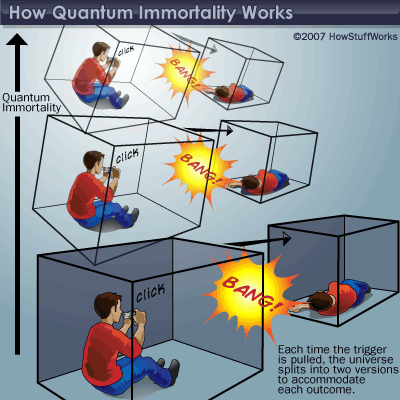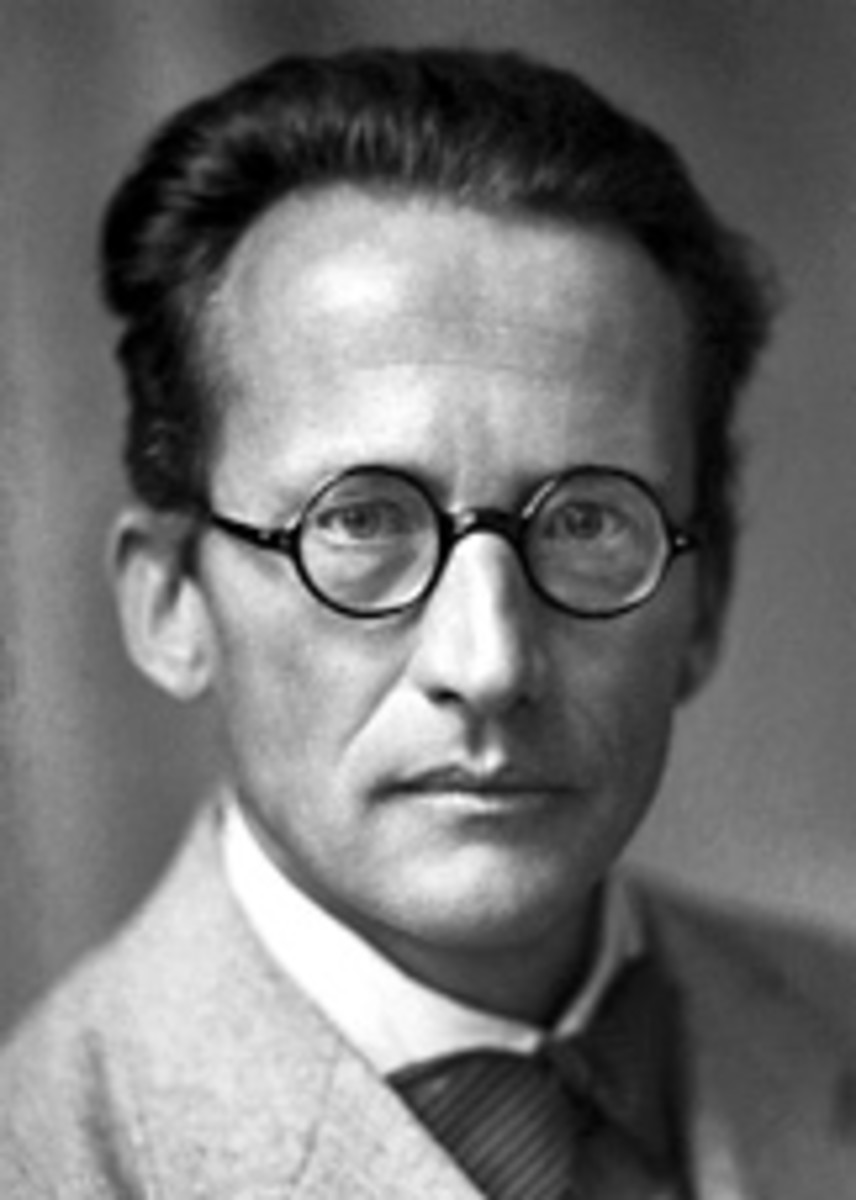Quantum Physics - quantum suicide (immortality)

Introduction
Quantum Suicide is a further thought experiment, it was developed by Hans Moravec in 1987 and further developed by Max Tegmark in 1998.
It’s goal is to distinguish between the Copenhagen interpretation of Quantum mechanics and Everett’s many worlds interpretation, more information can be found on this hub about Schrödinger’s cat, which I believe to be good reading before this hub as this is a variation the famous thought experiment devised by Erwin Schrodinger.
It takes Schrodinger’s cat and it is viewed from the perspective of the cat, however for the purpose of this experiment we will change the cat for a man.
The Experiment
Now this man is put into a sealed box just like the cat. He has a gun which is pointed at his head; this gun is attached to a device which measures the spin of an electron. This particle has a 50/50 chance of having a spin-up or a spin-down property, now when the trigger is pulled the spin is measured. If it is spin-up then the gun will fire if it is spin down the wont won’t fire.
Now the man in box fires the gun and click, it doesn’t fire, so he pulls it again and again, and again, he continues to pull it and the gun keeps producing the same result: It continues to not fire! The gun is working properly and is loaded with bullets however no matter how many times he pulls the trigger; the gun will never fire, resulting in quantum immortality.
This is a metaphysical speculation derived from the quantum suicide thought experiment. It states that the many-worlds interpretation of quantum mechanics implies that conscious beings are immortal. Hugh Everett is reported to have believed in quantum immortality, although he never published on either quantum suicide or quantum immortality.
Splitting Universeres

Now if we go back in time to the beginning of the experiment and the quantum particle spin is measured as being spin-up, hence the gun fires! But wait a minute, the man already pulled the trigger the first time and an infinite amount of times after that and the gun never fired! So how can the man be dead? Well the fact is he is both dead and alive, each time he pulls the trigger the universe splits into two one with each of the two possible events. This will happen time and time again each time the trigger is pulled and this is how we become quantum immortal. See image on the right.
Many Worlds

Analysis and interpretations
With each run of the experiment there is a 50% chance the gun will fire killing the man. Now according to the Copenhagen interpretation if we keep running the experiment in all likelihood the gun will fire.
If the many-worlds interpretation is correct; then at each run of the experiment, the experimenter will be split into one world in which he survives and another world in which he dies. After many runs of the experiment, there will be many worlds. In the worlds where the experimenter dies, he will cease to be a conscious entity and hence is null and void as he can no longer ‘observe’.
This is important because we are thinking of this experiment from the ‘point of view’ of the man in the sealed box then all of the non-dead copies of him will perceive the experiment to continue to run without his untimely demise, therefore "proving" himself to be invulnerable to the gun mechanism in question, at least from his own point of view. As long as the gun remains unheard to outside observers and the experimenters box remains sealed to prevent quantum measurement and the collapse of the wavefunction.
Believe it or not Quantum suicide does not break any known laws of physics as long as some assumptions are true, those being:
- That the many-worlds interpretation is the correct interpretation of quantum mechanics, as opposed to the Copenhagen interpretation which, does not involve the existence of parallel universes. NB// Parallel universes may be possible through other mechanisms in the Copenhagen interpretation.
- All of the possible scenarios in which the proposed experimenter (or any entity being argued about in the thought experiment) can die support a non-null subset of survival scenarios.
- Not dying some finite number of times perhaps (in the split worlds) constitutes immortality.
- Permanent halt of consciousness, and the ability to ‘observe’, occurs when the gun is fired.
One of the main arguments against this was put forward by Mallah, he said that:
“Quantum suicide cannot give a recipe for ‘entering into’ rare or ‘low measure’ observer moments, because the amount of consciousness or "measure" of these rare observer moments is exactly as much as it would have been without the quantum suicide; in that case quantum suicide merely removes the other observer-moments.
This is equivalent to a single-world situation in which one starts off with many copies of the experimenter, and the number of surviving copies is decreased by 50% with each run. Therefore, according to this argument, the quantum nature of the experiment provides no benefit to the experimenter; in terms of his/her subjective life expectancy or rational decision making, or even in terms of his/her trying to decide whether the many-worlds interpretation is correct, the many-worlds interpretation gives results that are the same as that of a single-world interpretation”
Whilst this thought experiment is very controversial it again highlights the strangeness of the quantum world and again highlights the difficulties in distinguishing between different interpretations of quantum mechanics. However the very thought that this is what happens is surely worth a look. Take a look at some of the great books on the subject.









